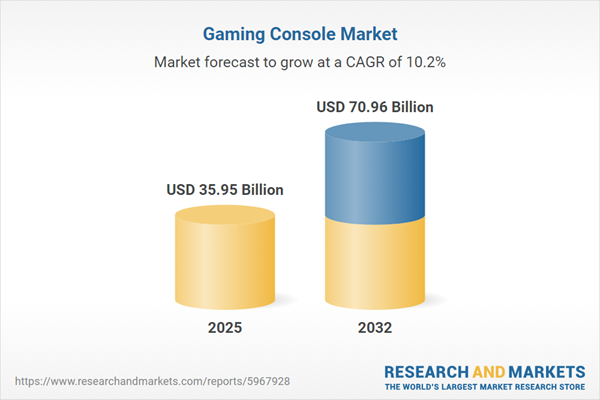Speak directly to the analyst to clarify any post sales queries you may have.
The gaming console market is undergoing dynamic transformation, shaped by emerging technologies and evolving user demands. Senior industry leaders must grasp the shifting landscape to inform strategy, unlock fresh opportunities, and maintain a competitive edge.
Market Snapshot: Gaming Console Market Size and Growth
The gaming console market grew from USD 32.61 billion in 2024 to USD 35.95 billion in 2025. It is projected to expand at a CAGR of 10.20%, reaching USD 70.96 billion by 2032.
Scope & Segmentation: In-Depth Market Coverage
This report delivers comprehensive analysis across critical segments and regions shaping the global gaming console market:
- Console Types: Handheld consoles (covering both next generation and previous generation devices), home consoles (both current and legacy), and hybrid consoles combining portability and stationary use.
- Distribution Channels: Offline (brick-and-mortar) and online channels, each reflecting different consumer preferences and localization needs.
- End User Profiles: Casual users prioritizing ease of access, hardcore enthusiasts focused on immersive narratives, and professional users seeking competitive performance.
- Regional Coverage:
- Americas: United States, Canada, Mexico, Brazil, Argentina, Chile, Colombia, Peru
- Europe, Middle East & Africa: United Kingdom, Germany, France, Russia, Italy, Spain, Netherlands, Sweden, Poland, Switzerland, United Arab Emirates, Saudi Arabia, Qatar, Turkey, Israel, South Africa, Nigeria, Egypt, Kenya
- Asia-Pacific: China, India, Japan, Australia, South Korea, Indonesia, Thailand, Malaysia, Singapore, Taiwan
- Leading Companies: Sony Interactive Entertainment LLC, Nintendo Co., Ltd., Microsoft Corporation, Valve Corporation, NVIDIA Corporation, Atari SA, SNK CORPORATION, Intellivision Entertainment LLC, Hyperkin Inc., Analogue Inc.
Key Takeaways for Senior Executives
- Disruptive innovations in hardware and software now drive differentiation, making platform integration crucial for sustained relevance.
- Cloud gaming, augmented reality, and real-time content delivery are changing both consumption patterns and user expectations.
- Distribution channels are rapidly evolving, as the industry shifts towards online transactions, direct-to-consumer strategies, and hybrid sales models—demanding agile response from vendors.
- Flexibility in manufacturing, especially with regard to tariffs and localized assembly, is an important risk management strategy for international supply chains.
- Segment-specific outreach—tailored marketing for casual, hardcore, and professional users—can enhance engagement and monetize micro-niches effectively.
- The increasing focus on sustainable product design and operational agility is emerging as a key factor in long-term competitive positioning.
Tariff Impact on Supply Chains and Sourcing
United States tariffs have introduced cost and sourcing challenges, compelling manufacturers to diversify supply chains, adopt lean manufacturing, and pursue local assembly options. Moreover, the impact of these tariffs is catalyzing new partnerships between hardware designers and component suppliers. Financial strategies now include long-term price agreements and hedging to mitigate volatility, while certified refurbishment programs address cost-conscious consumer segments.
Research Methodology & Data Sources
This market intelligence leverages a mixed-methods approach. Expert interviews span hardware engineers, developers, and supply chain leaders. The report applies triangulation of primary research, industry publications, financial datasets, and point-of-sale retail data. Analytical models assess scenarios, and subject-matter peer review upholds data integrity throughout the process.
Why This Report Matters
- Enables leadership teams to align product strategies with the latest technological advancements and consumer behaviors across global and regional segments.
- Equips organizations to anticipate market shifts triggered by regulatory policies such as tariffs, supporting agile supply chain and investment decisions.
- Clarifies competitive and innovation trends that inform partnership choices and resource allocation for sustained market differentiation.
Conclusion
The gaming console sector is experiencing rapid, multi-dimensional transformation. Equipped with strategic insights from this report, senior decision-makers can adapt more confidently to regulatory shifts, consumer evolution, and innovation trends central to long-term growth.
Additional Product Information:
- Purchase of this report includes 1 year online access with quarterly updates.
- This report can be updated on request. Please contact our Customer Experience team using the Ask a Question widget on our website.
Table of Contents
3. Executive Summary
4. Market Overview
7. Cumulative Impact of Artificial Intelligence 2025
Companies Mentioned
The companies profiled in this Gaming Console market report include:- Sony Interactive Entertainment LLC
- Nintendo Co., Ltd.
- Microsoft Corporation
- Valve Corporation
- NVIDIA Corporation
- Atari SA
- SNK CORPORATION
- Intellivision Entertainment, LLC
- Hyperkin, Inc.
- Analogue, Inc.
Table Information
| Report Attribute | Details |
|---|---|
| No. of Pages | 190 |
| Published | October 2025 |
| Forecast Period | 2025 - 2032 |
| Estimated Market Value ( USD | $ 35.95 Billion |
| Forecasted Market Value ( USD | $ 70.96 Billion |
| Compound Annual Growth Rate | 10.2% |
| Regions Covered | Global |
| No. of Companies Mentioned | 11 |









